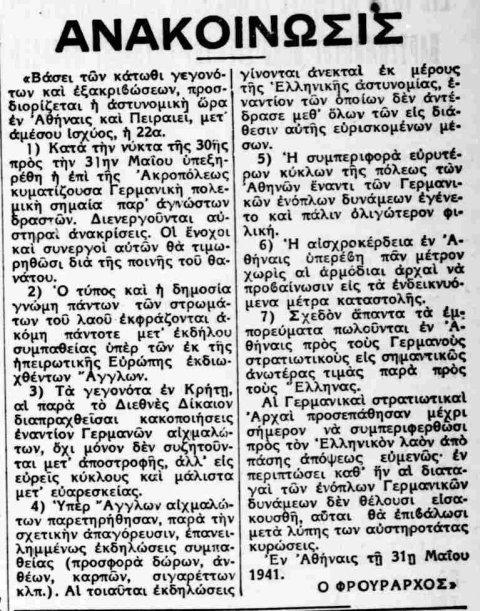On the night of 30-31 May 1941, two young Greeks, Manolis Glezos and Lakis Sandas, climbed the Acropolis cliff and took down the Nazi flag. It was a brave and important symbolic act against the occupying forces. This heroic act was the beginning of the great Greek resistance against the Nazis. It raised the morale of the Greeks and made them believe that there were ways to challenge the superior German forces.
Just over a month earlier, on 28 April 1941, the whole of humanity was humiliated when the swastika flag was raised on the Acropolis – the symbol of democracy and Western civilization. Athens had surrendered and Wehrmacht troops marched into the historic quarters.

Photo: Bundesarchiv, Bild 101I-164-0389-23A / Theodor Scheerer / CC-BY-SA 3.0, CC BY-SA 3.0 de, https://commons.wikimedia.org/w/index.php?curid=5476326
The feat gets forgotten.
The two young men made their action known through independent statements in 1945. But in the difficult decades that followed, with civil war, persecutions, military dictatorship and more, the heroic act fell almost into oblivion.
It wasn’t until 1982 that the story made headlines again when Glezos and Sandas were interviewed on a popular TV program. The show was hosted by Freddy Germanos, a well-known journalist in Greece. This legendary interview (in Greek) is what most sources refer to when they talk about the heroic deed.
The secret crypts of the Acropolis
As the two 19-year-old students walked through the streets of Athens and saw the swastika waving over the sacred rock of the Acropolis, they decided to take action. The idea began to take shape in their minds. However, they quickly realized that careful preparation was needed before they could put their plan into action.
Glezos and Sandas got straight down to studying maps and literature about the Acropolis at the National Library. They read in the Great Greek Encyclopedia about the many tunnels and caves under the ancient rock. They realized that their only way past the German guards was through one of these hidden entrances. After careful study of the terrain, they decided on a particular crypt under the Acropolis that would be their way up that fateful night.

It’s been a bit of a mystery over the years about where exactly the cave opening was that they used to ascend the Acropolis cliff. They referred to it as Σπήλαιο της Αγραύλου/Agravlou Cave, but several local names have changed since 1941, and their memories have also been a little unclear at various times.
However, by studying their testimonies and statements, archaeologists have in recent years begun to identify the entrance as the Mycenaean Fountain, which has been known since antiquity, located on the north side of the Acropolis. Manolis Korres, professor emeritus at the Technical University of Greece and chairman of the Acropolis Conservation Committee, has spoken in favor of this theory in interviews. Therefore, while the heroes’ own statements can’t be entirely dismissed, the ‘Mycenaean Spring’ seems the most likely place from which the brave action began.
The plan gets implemented
On 30 May 1941, Glezos and Sandas heard on the radio that Crete had fallen into German hands. This became the impetus for them to put their bold plan into action.
That same midnight, they climbed up the cliff to try to take down the large, 4×2-meter Nazi flag. After three attempts at the top of the Acropolis, they finally managed to get it down. They cut off a piece around the swastika as a souvenir and threw the rest of the flag into a nearby dry well.
It was only the next morning that the German garrison discovered that their flag was missing from the mast of the Acropolis. The Nazis reacted harshly after their flag was taken down. The commander of the guard forces immediately issued a sharp communiqué:
“… On the night of 30-31 May, the German war flag was desecrated by being hauled down from the Acropolis by unknown perpetrators. Rigorous interrogations are underway. The culprits and their accomplices will be punished by death…“
Glezos and Santas were immediately sentenced to death in absentia. The German guard force was executed as punishment for not guarding the area properly. The local Greek police chiefs around the Acropolis were also immediately dismissed from their posts.

It’s worth noting that the Germans themselves announced the tearing down of the flag, which made the heroic act known all over Greece immediately and even attracted international attention. According to the Larousse Britannica encyclopedia, it led French President General de Gaulle to describe Manolis Glezos as “Europe’s first partisan'”
The anonymous heroes
The bold act of tearing down the Nazi flag from the Acropolis had a huge symbolic impact.
For the Nazis, seeing their flag removed from one of the world’s most important cultural sites was a huge embarrassment. Their harsh reprisals showed just how significant the action was. The event was also recognized internationally as a major act of resistance.
The Greek people were inspired to resist the occupying power, and the action was like a beacon of hope in the darkness. The civil courage of the two young students has been of great inspiration for future generations in their fight for freedom and democracy.
As Manolis Glezos often emphasizes, this action should be dedicated to all the anonymous heroes, up to 120,000 of them, who died, were executed, or were killed during the resistance against the Nazis. In most Greek families there is the memory of at least one such anonymous lost member who sacrificed their life for the homeland.
Sources:
https://www.liberal.gr/apopsi/apo-edo-anebikan-stin-akropoli-oi-glezos-santas
Freddy Germanos TV-program 1982
Wikipedia
